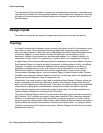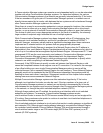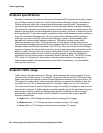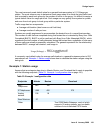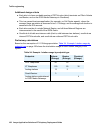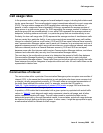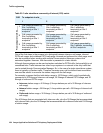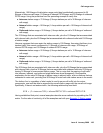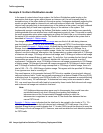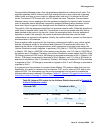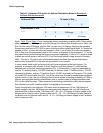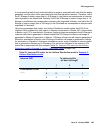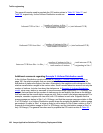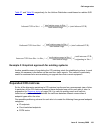
Traffic engineering
184 Avaya Application Solutions IP Telephony Deployment Guide
One of the first steps in the process is to distinguish between intercom call usage, inbound
PSTN call usage, and outbound PSTN call usage. Inbound and outbound tie trunk usage must
also be considered when working with multiple Communication Manager systems that
networked together. However, that discussion is presented in a later section.
Although Avaya systems can be used as tandem switches for PSTN traffic, that possibility is not
considered here. Traffic between two other Avaya systems in a network is the only traffic that
can be routed through Communication Manager. So, in the case of a single stand-alone system,
there is typically no tandem traffic. Therefore, because every call involves at least one station,
one must be careful to reconcile the station usage with the call usage.
For example, suppose that the total station usage is 100 Erlangs, which could hypothetically
correspond to 20 Erlangs of intercom call usage, 30 Erlangs of inbound PSTN usage, and 30
Erlangs of outbound PSTN usage:
● Intercom station usage = 40 Erlangs (2 Avaya stations per call x 20 Erlangs of intercom
call usage)
● Inbound station usage = 30 Erlangs (1 Avaya station per call x 30 Erlangs of inbound call
usage)
● Outbound station usage = 30 Erlangs (1 Avaya station per call x 30 Erlangs of outbound
call usage)
The 40 Erlangs that are associated with intercom calls, plus the 30 Erlangs that are associated
with inbound calls, plus the 30 Erlangs that are associated with outbound calls total 100 Erlangs
of station usage.
Table 25: 3-site standalone community of interest (COI) matrix
CUR To endpoints in site __
1 2 3
From endpoints in Site ____
1
Call usage generated by
Site 1 endpoints,
terminating at Site 1
endpoints
Call usage generated by
Site 1 endpoints,
terminating at Site 2
endpoints
Call usage generated by
Site 1 endpoints,
terminating at Site 3
endpoints
2
Call usage generated by
Site 2 endpoints,
terminating at Site 1
endpoints
Call usage generated by
Site 2 endpoints,
terminating at Site 2
endpoints
Call usage generated by
Site 2 endpoints,
terminating at Site 3
endpoints
3
Call usage generated by
Site 3 endpoints,
terminating at Site 1
endpoints
Call usage generated by
Site 3 endpoints,
terminating at Site 2
endpoints
Call usage generated by
Site 3 stations, terminating
at Site 3 endpoints





